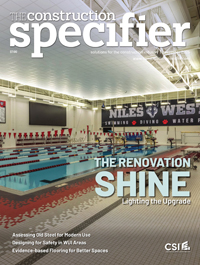Back To basics: Understanding sprayfoam insulation

Spray polyurethane foam, also referred to simply as sprayfoam, is commonly used across the United States in a wide variety of commercial building projects as insulation. Professionally spray applied by trained contractors, the material is used in both new construction and in retrofit projects across most major real estate types, including office, retail, industrial, mixed-use, agricultural, institutional, and apartment (as well as in for-sale residential) properties.
Notably, the range of spray polyurethane foam insulation available for specification has shifted over the past few years. Many traditional and long-standing sprayfoam insulation systems have been eliminated from production and sale, specifically within the United States. The phased-out sprayfoam insulations are those produced using hydrofluorocarbons (HFCs).
The challenge with HFCs
HFCs are a group of organic compounds composed of hydrogen, fluorine, and carbon. These have been widely used in a range of cooling systems (including refrigerators, freezers, and automotive air conditioning units), as well as in the blowing agents used in the production of polymer foams (including sprayfoam insulation),1 aerosols, and fire extinguishing systems. A blowing agent is the substance that produces the cellular structure of the foam during the foaming process, which then leads to the foam hardening (i.e. curing).2
HFCs are considered greenhouse gases (GHGs) with high global warming potential (GWP). Greenhouse gases trap heat in the atmosphere and while HFCs typically emit in lower quantities in comparison to other greenhouse gases, they are potent and thus considered high-GWP gases. This is because for a given amount of mass, they trap substantially more heat than CO2.3 These factors have led to ongoing concerns about the negative impacts of HFCs on the environment, especially as economic growth spurs demand for increased usage.4
The HFC ban explained
Mandated by the U.S. Environmental Protection Agency (EPA) as of January 1, 2025, certain technologies may no longer use high-GWP HFCs or HFC blends. The prohibition encompasses the manufacture, distribution, sale, installation, import, and export of products containing restricted HFCs as well as the installation of new systems that use restricted HFCs.5 This ban necessitated the U.S. market’s at-large sunsetting of spray polyurethane foam insulations with HFC-based blowing agents.
The ban necessitates contractors to work with other sprayfoam systems, while delivering a silver lining to specifiers, architects, builders, and the end users of buildings. Each group now benefits from newer generation spray foams with reduced environmental impacts. Spray polyurethane foam insulations with HFC-based blowing agents have been fully replaced in the U.S. with sprayfoam insulations using hydrofluoroolefin (HFO-based) blowing agents. HFOs are compounds consisting of hydrogen, fluorine and carbon, and typically have very low GWPs.6
Specifying sprayfoam insulation
Even with the removal of HFC sprayfoam insulation from the marketplace, there are still numerous options to choose from when specifying materials for a commercial building project, whether new construction or retrofit. All sprayfoam insulation options will fall into two major categories: open- or closed-cell sprayfoam. No matter the category, all options are designed to perform as both thermal insulation and an air barrier. Closed-cell spray foam insulations take that a step further, functioning as a combined one-product solution for thermal, air, and moisture control in the building envelope.
When professionally installed by a sprayfoam contractor, sprayfoam insulation adheres to most typical construction substrates, expanding in place where applied and sealing the building envelope. Substrates that would be difficult to adhere to are surfaces that are wet, dirty, or have a wax/resin finish.
The following is a review of the open- and closed-cell sprayfoam categories with guidance, common application uses, characteristics, and additional considerations for each. Notably, density and cell structure vary between open- and closed-cell sprayfoam, and these two factors impact both performance and uses.
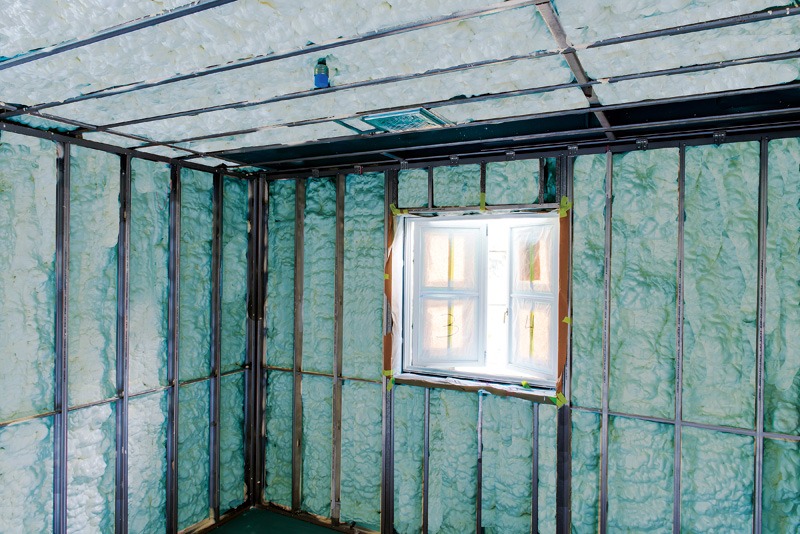
Open-cell sprayfoam insulation
Open-cell spray polyurethane foam systems are lower-density foam options with an open-cell structure. The density of open-cell foams is approximately 0.5 to 1.4 lb/cf (8 to 22 kg/m3), and the cell structure and density properties make these foam options more flexible or spongy to the touch compared to closed-cell alternatives.
Open-cell sprayfoams improve the energy efficiency of the building enclosure. The escape of conditioned air inside the structure (such as when indoor air was heated during cold months or cooled during warm months) is reduced. This, in turn, lowers the consumption of energy required by the structure to reheat or recool the air.
Additional considerations for open cell specification
Sound attenuation—One attribute specific to open-cell sprayfoams is sound attenuation. When installed in a structure, open-cell sprayfoam insulation reduces the detectable magnitude of noise present on the other side of the wall. Thus, if there is loud noise in the street, it is much less likely to be heard indoors if the insulation is installed in the building enclosure. If the material is installed in an interior wall, noise will be less detectable in the adjacent room on the other side of the partition wall.
Vapor permeability—Vapor permeability is another primary difference between open- and closed-cell sprayfoams. With higher vapor permeability, open-cell sprayfoams more freely release any vapor they absorb. This characteristic makes them much more suitable for interior applications, including installation in interior walls and ceilings, where water exposure risk is low and in warmer climates where vapor barriers are not required. Closed-cell spray foam, on the other hand, is better for controlling moisture and acting as a vapor barrier, therefore more suitable for colder climates where a vapor barrier is required and energy efficiency requirements are higher.

Closed-cell sprayfoam insulation
Closed-cell sprayfoam insulations are medium-density options, measured at 1.5 to 2.3 lb/cf (24 to 37 kg/m3). As the name implies, the cell structure of this category of foams is closed. These sprayfoams are significantly more rigid than open-cell foams.
The structure and density of closed-cell spray foams are physical attributes that help them achieve a higher R-value per inch (or RSI value per mm) than their open-cell counterparts. The greater the insulation’s R-value (or RSI value), the measurement of an insulation’s resistance to conductive heat flow, the more effective the material. Thus, closed-cell spray foams provide greater thermal insulation performance than open-cell options.
The advised R-value (or RSI value), or amount of insulation needed to be applied in any given structure depends on the climate zone, capabilities of the HVAC system, and location in the structure where the insulation will be installed.7 The International Energy Conservation Code (IECC), provides a map of climate zones by U.S. counties and territories with designations for each. It also offers product rating, marking and installation requirements for insulation (and other materials).8
Closed-cell sprayfoam insulation is ideally suited for use as continuous insulation (c.i.) to reduce or even eliminate thermal bridging. The material can be used in both interior and exterior applications where it replaces commonly used rigid extruded polystyrene insulation (XPS), mineral wool, and polyisocyanurate (polyiso) foam boards. It offers low water absorption and mold resistance, as demonstrated with ASTM C1338. Closed-cell sprayfoam excels as a water-resistant barrier on exterior applications and is tested in accordance with ASTM E2357 with a pressure up to 300 Pa (6.2 pfs) for air barrier assemblies, which includes the ASTM E331 (AC71) water penetration testing. The result was no leakage through the sprayfoam.
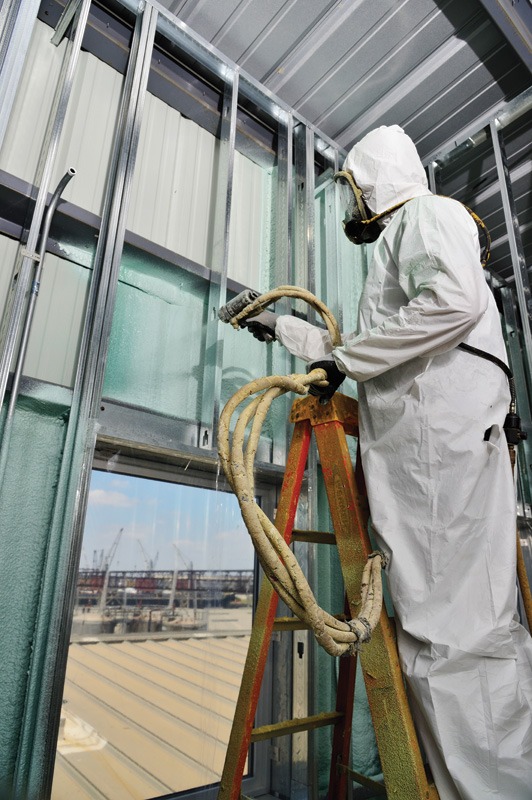
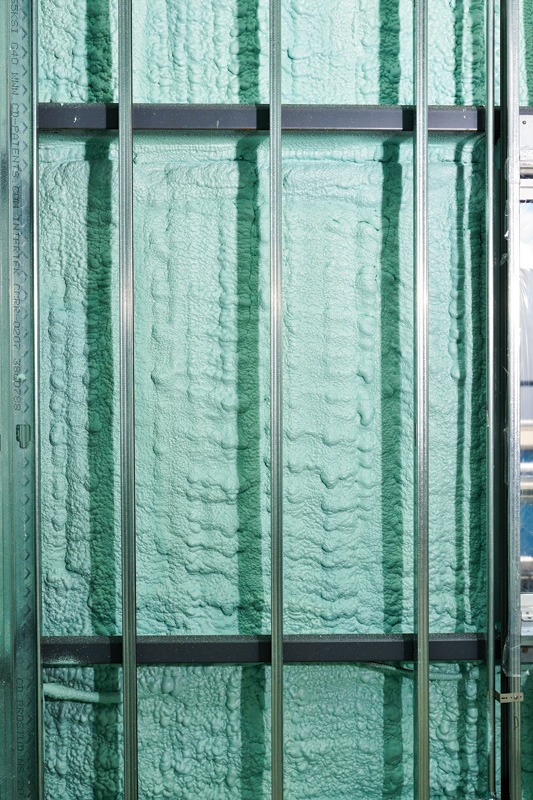
Additional considerations for closed-cell specification
Flood resistance—FEMA rates closed-cell sprayfoam insulation a Class 5 material, the highest classification for products indicating strong resistance to floodwater damage, specifically when the material is applied in walls, ceilings, and floors. Class 5 materials do not require special waterproofing protection, can survive wetting and drying, and may be cleaned after a flood to free them of most harmful pollutants.9 Due to these attributes, closed-cell sprayfoam saves time and money for owners of sprayfoam-insulated commercial structures, which have experienced flooding. Notably, the FEMA Class 5 rating applies when the closed-cell sprayfoam is installed as either cavity insulation or as c.i. The material is also the only cavity insulation approved by FEMA with the highest floodwater resistance. When applied under slab as insulation, closed-cell sprayfoam is also flood-resistant.
Vapor requirements—Closed-cell sprayfoam insulation installed at a thickness of 25.4 mm (1 in.) meets Class II vapor requirements for colder climates. Therefore, it removes the need for an additional vapor barrier when Class II is required.
Radon prevention—The leading cause of lung cancer in non-smokers in the United States is exposure to radon, a naturally occurring radioactive gas that occurs when uranium in soil and rocks breaks down. Outdoors, there is little human health risk posed by radon, however, the gas can accumulate in buildings and homes, especially in basements and on ground levels, if it seeps into the structure.10 Closed-cell sprayfoam insulation can be used to prevent the gas from entering the structure at common points of entry in a seven-step process that includes: subfloor preparation, installation of a depressurization pipe, installation of water drains, installing closed-cell sprayfoam insulation to act as an air barrier, sealing joints with the sprayfoam, sealing all openings and penetrations with the sprayfoam, and installing a sealed lid on sumps.
Structural strength and wind resistance—When installed, closed-cell spray polyurethane foam insulation essentially glues the assembly together, reducing potential for movement and adding an approximate tensile strength in the range of 103 to 172 kPa (15 to 25 psi).11 Installed in above-grade walls, the material can also increase wind resistance. The degree of hardening primarily depends on the initial strength of the structure. As a comparison, an I-beam modular constructed metal building with a 22-gauge metal panel will benefit much less from an interior application of closed-cell sprayfoam than a post-frame constructed building with 29-gauge corrugated metal panels.
In 1992, 1996, and 2007, the Spray Polyurethane Foam Alliance (SPFA) completed racking performance tests at Architectural Testing, Inc. in Pennsylvania. The testing demonstrated that medium-density closed-cell sprayfoam installed at 32 kg/m3 (2.0 lb/cf) increases racking strength by 70 to 200 percent in wall assemblies sheathed with oriented strand board (OSB), plywood, gypsum wallboard, vinyl siding, and polyiso board. The research also proved closed-cell SPF improved the rack and shear strength in wood and metal construction. Installed sprayfoam also increases the strength of weaker variety substrates, including gypsum drywall, vinyl siding, and polyiso foam insulation, to a larger degree than stronger substrates such as OSB and plywood. Special wind resistance bracing is also not required to strengthen when applying the material to walls.12
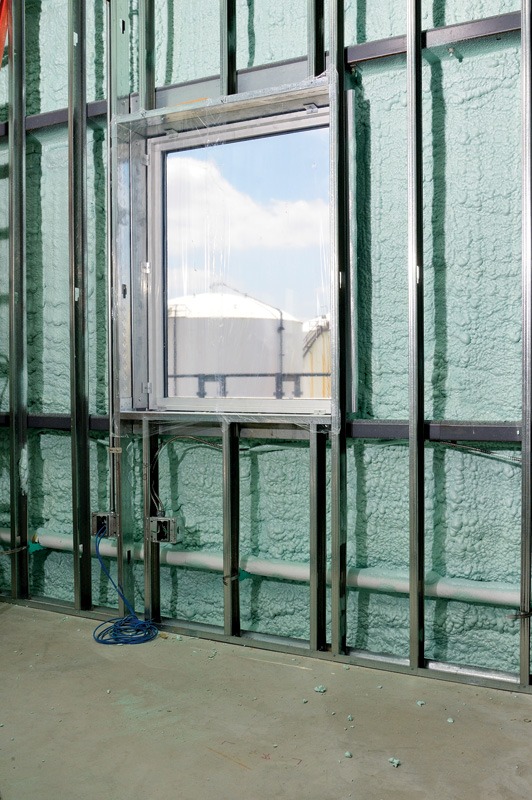
Pests, pollution, and allergens—Due to its sealing capabilities, closed-cell sprayfoam insulation reduces the number of pests (e.g. insects), harmful pollutants, and allergens that can enter the structure. Additionally, it acts as a secondary water barrier, protecting the structure and its users from mold and mildew formation.
When considering spray polyurethane foam insulation for commercial projects, it is always advisable to review the attribute and performance characteristics of the various options against the project’s building envelope performance goals, climate zone and weather considerations, budget, and any other project parameters. Some sprayfoam insulation applications can reduce the number of other materials needed for specification, while other options may provide different benefits such as noise reduction. A variety of options are available to meet specific needs.
Notes
1 See.
2 Refer.
3 Learn more.
4 See.
5 Review.
6 See.
7 Refer.
8 See the code.
9 Refer to FEMA, Flood Damage-Resistant Materials Requirements for Buildings Located in Special Flood Hazard Areas in Accordance with the National Flood Insurance Program, Technical Bulletin 2, August 2008
10 Visit.
11 Refer to Honeywell, Insulation and Waterproofing for Metal Buildings and Metal Roof Systems: The Case for Using Better Insulation and Waterproofing Technologies in Metal Roof Systems and Metal Buildings.
12 See Architectural Testing, Performance Test Report Rendered to Spray Polyurethane Foam Alliance, Project: Racking Load Tests, 2007.
13 To learn more about open- and closed-cell density range, refer to The Construction Specifier, “Navigating the Different Densities of Sprayfoam,” from the September 2017 issue.
Author
Maxime Duzyk is senior global director of building science and engineering for Huntsman Building Solutions, a global leader in spray polyurethane foam solutions. He has a background in architecture and has been in the spray polyurethane foam insulation business for the last 15 years. Duzyk is involved with different building envelope committees and associations in North America, including CSC, SFC, SPFA, CCMC, and ULC Standards. Visit Huntsman Building Solutions online at www.huntsmanbuildingsolutions.com and contact Duzyk at mduzyk@huntsmanbuilds.com.
Key Takeaways
Spray polyurethane foam (SPF) insulation is widely used in U.S. commercial and residential projects. With the Environmental Protection Agency’s (EPA’s) 2025 hydrofluorocarbon (HFC) ban, only low–global warming potential (GWP) hydrofluoroolefin (HFO)-based sprayfoams remain. Open- and closed-cell systems provide insulation, air sealing, and performance benefits, with closed-cell delivering higher resistance values, moisture protection, and structural strength.




